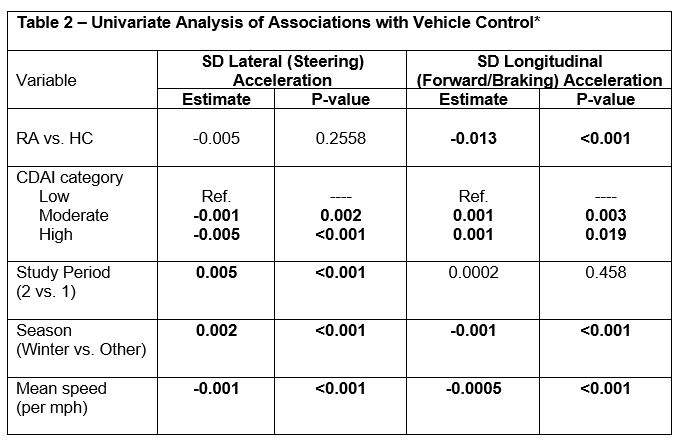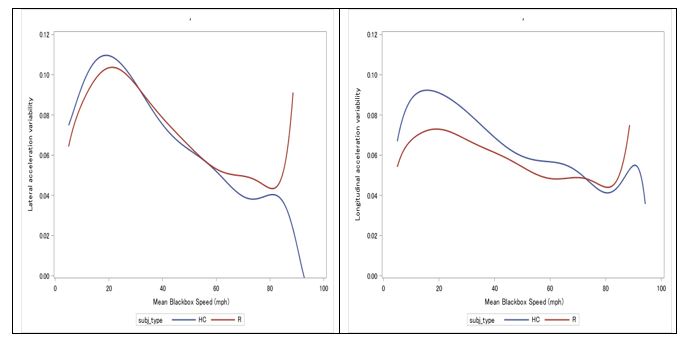Session Information
Date: Friday, November 6, 2020
Title: RA – Diagnosis, Manifestations, & Outcomes Poster I: Multimorbidity
Session Type: Poster Session A
Session Time: 9:00AM-11:00AM
Background/Purpose: Automobile driving is an instrumental activity of daily living. Owing to symptoms and functional impairment, patients with rheumatoid arthritis (RA) rely disproportionately on driving for the preservation of health, well-being, and quality of life1. To date, there have been no rigorously designed prospective studies examining driving performance in patients with RA. This prospective cohort study compared variability in longitudinal (acceleration/braking) and lateral (steering) vehicle acceleration as measures of vehicle control between drivers with RA and healthy controls (HC).
Methods: Patients with RA were recruited from an academic rheumatology practice and were required to have at least one swollen joint and a CDAI score ≥6 to participate. HCs were recruited using advertisements and a pool of local study volunteers. Data collection occurred over 2, 4-week periods (separated by 2 months) of continuous naturalistic driving observation. Driving data were collected using instrumentation installed in participants’ own vehicles, collecting video, audio, GPS, speed, acceleration and engine data. Data were aggregated into 45-second segments (from start-to-end) of uninterrupted driving. Segments with >20 seconds of missing data or mean speeds < 5 mph were excluded. Associations of disease status (RA vs. HC) and disease activity (CDAI score, RA only) with acceleration variability (standard deviations, SDs) were examined using mixed-effect linear regression models, accounting for between-patient variability.
Results: Characteristics of RA and HC subjects are shown in Table 1. There were 232,538 driving segments (2,906 driving hours) analyzed. Factors associated with variability in longitudinal and lateral acceleration included RA disease status, higher disease activity in RA, study period, season, and mean vehicle speed (Table 2, Figure 1). Increases in disease activity between periods 1 and 2 tended to produce more erratic braking/accelerating (increased longitudinal variability; estimate = 0.0004; p = 0.05) without affecting steering.
Conclusion: To our knowledge, this is the first study quantifying naturalistic driving in the real world in patients with RA. These results link RA and heighted arthritis disease activity with aberrant vehicle control. Specifically, increased RA disease activity reduces steering variability while simultaneously increasing erratic/harsh braking and accelerating. These findings support the need for further research to map these observed patterns in vehicle control to metrics of driver risk, and, in turn, to link patterns of real world driving behavior to diagnosis and disease activity.
1. Vrkljan BH et al. Supporting safe driving with arthritis: developing a driving toolkit for clinical practice and consumer use. Am J Occup Ther. 2010;64(2):259-67.
 *HAQ-II = Health Assessment Questionnaire-II; CDAI = Clinical Disease Activity Index
*HAQ-II = Health Assessment Questionnaire-II; CDAI = Clinical Disease Activity Index
 *Significant associations shown in bold; CDAI = Clinical Disease Activity Index; RA = rheumatoid arthritis; HC = healthy controls; mph = miles per hour
*Significant associations shown in bold; CDAI = Clinical Disease Activity Index; RA = rheumatoid arthritis; HC = healthy controls; mph = miles per hour
 Figure 1: Plot of variability in lateral (left panel) and longitudinal (right panel) acceleration by vehicle speed
Figure 1: Plot of variability in lateral (left panel) and longitudinal (right panel) acceleration by vehicle speed
To cite this abstract in AMA style:
Michaud K, Merickel J, Gwon Y, Sayles H, Kampschnieder H, Hiebert R, Petro A, England B, Rizzo M, Mikuls T. A Prospective Cohort Study of Vehicle Control as a Measure of Driving Performance in Patients with Rheumatoid Arthritis [abstract]. Arthritis Rheumatol. 2020; 72 (suppl 10). https://acrabstracts.org/abstract/a-prospective-cohort-study-of-vehicle-control-as-a-measure-of-driving-performance-in-patients-with-rheumatoid-arthritis/. Accessed .« Back to ACR Convergence 2020
ACR Meeting Abstracts - https://acrabstracts.org/abstract/a-prospective-cohort-study-of-vehicle-control-as-a-measure-of-driving-performance-in-patients-with-rheumatoid-arthritis/
